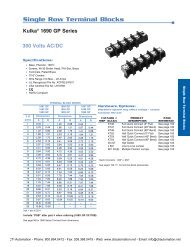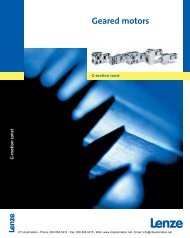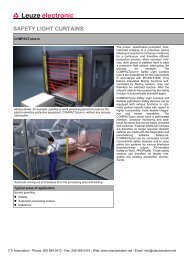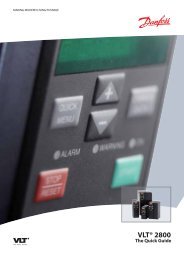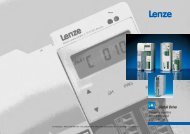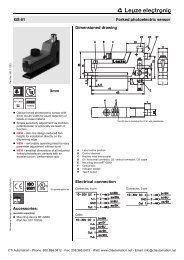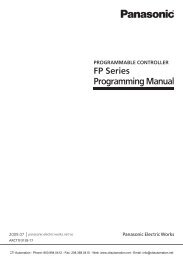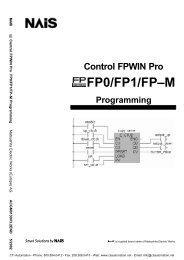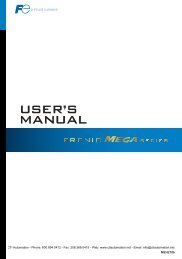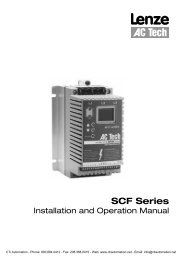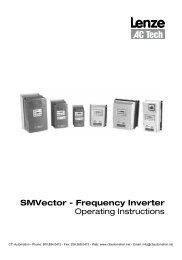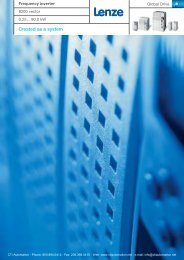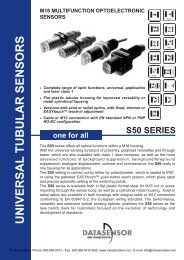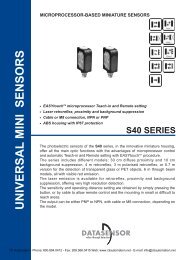FUJI FRENIC 5000P11 & 5000G11 Series Inverters - CTi Automation
FUJI FRENIC 5000P11 & 5000G11 Series Inverters - CTi Automation
FUJI FRENIC 5000P11 & 5000G11 Series Inverters - CTi Automation
You also want an ePaper? Increase the reach of your titles
YUMPU automatically turns print PDFs into web optimized ePapers that Google loves.
Indication Operation mode (Running)<br />
Item Explanation<br />
LED monitor<br />
G11S/P11S<br />
• Output frequency 1 (Before slip compensation) (Hz)<br />
• Output frequency 2 (After slip compensation) (Hz)<br />
Operation monitor & Alarm monitor<br />
• Setting frequency (Hz)<br />
Operation monitor<br />
• Output current (A)<br />
• Displays operation guidance<br />
• Output voltage (V)<br />
• Bargraph: Output frequency (%), Output current (A), Output torque (%)<br />
• Motor synchronous speed (r/min)<br />
Alarm monitor<br />
• Line speed (m/min)<br />
• Load shaft speed (r/min)<br />
• The alarm data is displayed when the inverter trips.<br />
• Torque calculation value (%)<br />
• Input power (kW)<br />
Function setting & monitor<br />
• PID reference value<br />
Function setting<br />
• PID reference value (remote)<br />
• PID feedback value<br />
Displays function codes and its data or data code, and changes the data value.<br />
• Trip history :Cause of trip by code (Even when main power supply is off,<br />
trip history data of the last 4 trips are retained.)<br />
Stopping<br />
Trip mode<br />
Selected setting value or output value<br />
Displays the cause of trip by codes as follows.<br />
Operation condition<br />
• Output frequency (Hz)<br />
• Output current (A)<br />
• Motor synchronous speed (r/min)<br />
• Load shaft speed (r/min)<br />
• OC1 (Overcurrent during acceleration)<br />
• Output voltage (V)<br />
• Line speed (m/min)<br />
• OC2 (Overcurrent during deceleration)<br />
• Torque calculation value (%) • PID reference value<br />
• OC3 (Overcurrent during running at constant speed)<br />
• Setting frequency (Hz)<br />
• Operation condition<br />
• PID feedback value<br />
• Driving torque limiter setting vaiue (%)<br />
• EF (Ground fault)<br />
• Lin (Input phase loss)<br />
(FWD / REV, IL, VL / LU, TL) • Braking togue limiter setting value (%)<br />
• FUS (Fuse blown)<br />
Tester function<br />
• OU1 (Overvoltage during acceleration)<br />
(I/O check)<br />
• OU2 (Overvoltage during deceleration)<br />
• OU3 (Overvoltage running at constant speed)<br />
• Digital I/O : (ON), (OFF)<br />
• Analog I/O: (V), (mA), (H), (p/s)<br />
• LU (Undervoltage)<br />
• OH1 (Overheating at heat sink)<br />
Maintenance data<br />
• OH2 (External thermal relay tripped)<br />
• OH3 (Overtemperature at inside air)<br />
• Operation time (h)<br />
• DC link circuit voltage (V)<br />
• Temperature at inside air (°C)<br />
• Cooling fan operation time (h)<br />
• Communication error times<br />
(KEYPAD,RS-485, Option)<br />
• dBH (Overheating at DB circuit)<br />
• Temperature at heat sink (°C) • ROM version<br />
• OL1 (Motor 1 overload)<br />
• OL2 (Motor 2 overload)<br />
• OLU (Inverter unit overload)<br />
• Maximum current (A)<br />
• Main circuit capacitor life(%)<br />
• Control PC board life (h)<br />
(Inverter, KEYPAD, Option)<br />
• OS (Overspeed)<br />
Load factor calculation<br />
• PG (PG error)<br />
• Er1 (Memory error)<br />
• Measurement time (s)<br />
• Maximum current (A)<br />
• Average current (A)<br />
• Average braking power (%)<br />
• Er2 (KEYPAD panel communication error)<br />
Alarm data<br />
• Er3 (CPU error)<br />
• Output frequency (Hz) • Temperature at inside air (°C)<br />
• Er4 (Option error)<br />
• Er5 (Option error)<br />
• Output current (A)<br />
• Output voltage (V)<br />
• Torque calculation value (%)<br />
• Hest sink temperature (°C)<br />
• Communication error times<br />
(KEYPAD,RS-485, Option)<br />
• Er6 (Operation procedure error)<br />
• Setting frequency (Hz) • Digital input terminal condition<br />
• Er7 (Output phase loss error, impedance imbalance)<br />
• Er7. (Charging circuit alarm, 40HP or larger)<br />
• Operation condition<br />
(FWD / REV, IL, VL / LU, TL)<br />
• Operation time (h)<br />
(Remote, Communication)<br />
• Transistor output terminal condition<br />
• Trip history code<br />
• Er8 (RS-485 error)<br />
• DC link circuit voltage (V) • Multiple alram exist<br />
Charge lamp When the DC link circuit voltage is higher than 50V, the charge lamp is ON.<br />
LCD monitor (Japanese, English, German, French, Spanish, Italian)<br />
Overload Protects the inverter by electronic thermal overload function and by detection of inverter temperature.<br />
Overvoltage Detects DC link circuit overvoltage,and stops the inverter. (460V : 800V DC, 230V : 400V DC)<br />
Undervoltage Detects DC link circuit undervoltage,and stops the inverter. (460V : 400V DC, 230V : 200V DC)<br />
Input phase loss Phase loss protection for power line input.<br />
Overheating Protects the inverter by detection of inverter temperature.<br />
Short-circuit Short-circuit protection for inverter output circuit<br />
Ground fault • Ground fault protection for inverter output circuit (3-phase current detection method) • Zero-phase current detection method (40HP or larger)<br />
Motor overload • The inverter trips,and then protects the motor. • Electronic thermal overload protection can be set for standard motor or inverter motor<br />
• Thermal time constant (0.5 to 75.0 minutes) can be preset for a special motor.<br />
• The second motor's electronic thermal overload protection can be preset for 2-motor changeover operation.<br />
DB resistor overheating • Prevents DB resistor overheating by internal electronic thermal overload relay (10HP or smaller).<br />
• Prevents DB resistor overheating by external thermal overload relay attached to DB resistor (15HP or larger).<br />
(The inverter stops electricity discharge operation to protect the DB resistor.)<br />
Stall prevention • Controls the output frequency to prevent (overcurrent) trip when the output current exceeds the limit value during acceleration.<br />
• Lowers the output frequency to hold almost constant torque when the output current exceeds the limit value during operation at constant speed.<br />
• Controls the output frequency to prevent (overvoltage) trip when the DC link circuit voltage exceeds the limit value during deceleration.<br />
Output phase loss When the inverter executes auto-tuning, detects each phase impedance imbalance.<br />
Motor protection by PTC thermistor When the motor temperature exceeds allowable value, the inverter trips automatically.<br />
Auto reset When the inverter is tripped, it resets automatically and restarts.<br />
Installation location* Free from corrosive gases, flammable gases, oil mist, dusts, and direct sunlight.<br />
Indoor use only.<br />
* If the inverter has to be used in an atmosphere including<br />
the hydrogen sulfide gases, a special model might be available.<br />
Contact Fuji Electric FA.<br />
Altitude 3300ft(1000m) or less. Applicable to 9800ft(3000m) with power derating (-10%/3300ft(1000m))<br />
Ambient temperature –10 to +50 °C(14 to 122°F). For inverters of 30HP or smaller, remove the ventilation covers when operating it at a temperature of 40°C(104°F) or above.<br />
Ambient humidity 5 to 95%RH (non-condensing)<br />
Vibration 3mm at from 2 to less than 9Hz, 9.8m/s2 at from 9 to less than 20Hz,<br />
2m/s2 at from 20 to less than 55Hz (2m/s2 at from 9 to less than 55Hz :G11S 125HP, P11S 150HP or more)<br />
1m/s2 Protection<br />
Condition<br />
(Installation<br />
and<br />
operation)<br />
at from 55 to less than 200Hz,<br />
Storage condition -Temperature : –25 to +65 °C(-13 to 149°F), -Humidity : 5 to 95%RH (non-condensing)<br />
11



